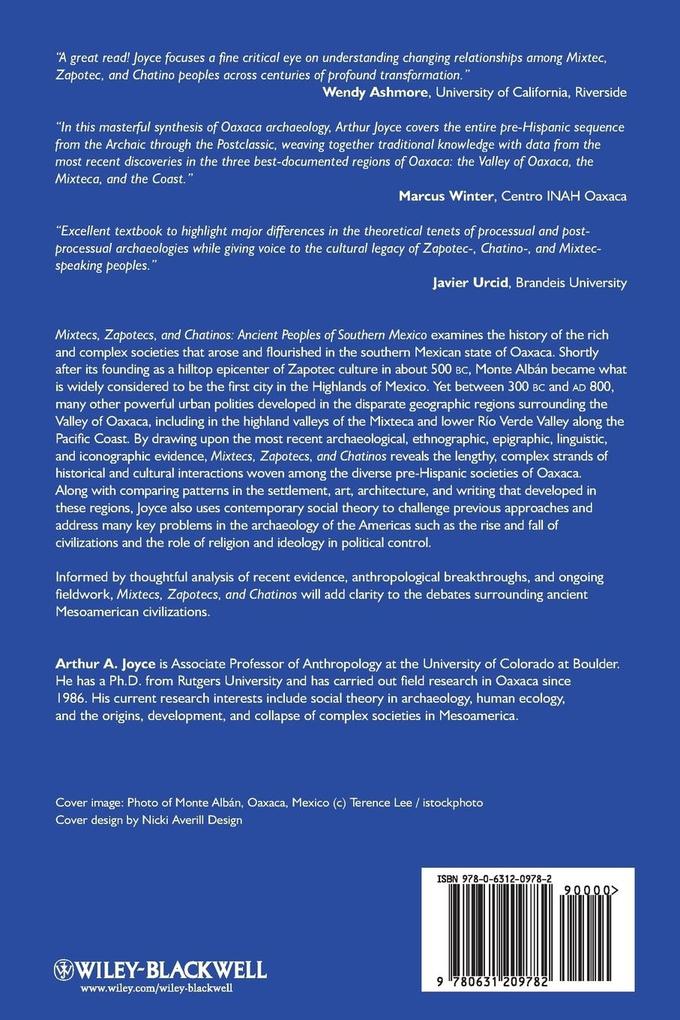
Zustellung: Fr, 11.07. - Mi, 16.07.
Versand in 2 Wochen
VersandkostenfreiBestellen & in Filiale abholen:
Mixtecs, Zapotecs, and Chatinos: Ancient Peoples of Southern Mexico examines the history of the rich and complex societies that arose and flourished in the southern Mexican state of Oaxaca. Shortly after its founding as a hilltop epicenter of Zapotec culture in about 500 bc, Monte Albán became what is widely considered to be the first city in the Highlands of Mexico. Yet between 300 bc and ad 800, many other powerful urban polities developed in the disparate geographic regions surrounding the Valley of Oaxaca, including in the highland valleys of the Mixteca and lower Río Verde Valley along the Pacific Coast. By drawing upon the most recent archaeological, ethnographic, epigraphic, linguistic, and iconographic evidence, Mixtecs, Zapotecs, and Chatinos reveals the lengthy, complex strands of historical and cultural interactions woven among the diverse pre-Hispanic societies of Oaxaca. Along with comparing patterns in the settlement, art, architecture, and writing that developed in these regions, Joyce also uses contemporary social theory to challenge previous approaches and address many key problems in the archaeology of the Americas such as the rise and fall of civilizations and the role of religion and ideology in political control. Informed by thoughtful analysis of recent evidence, anthropological breakthroughs, and ongoing fieldwork, Mixtecs, Zapotecs, and Chatinos will add clarity to the debates surrounding ancient Mesoamerican civilizations.
Inhaltsverzeichnis
List of Figures ix Preface xiii
1 People, Culture, and History 1
Sources of Evidence 5
Theorizing Oaxaca's Ancient Past 17
2 Peoples and Landscapes on the Eve of the Spanish Conquest 35
The Physical Geography of Oaxaca 36
Mixtec and Zapotec Peoples at the Time of the Spanish Conquest 42
3 From Foragers to Village Life 64
First Peoples 65
The Archaic Period and the Origins of Agriculture 66
The Transition to Sedentism 70
Negotiating Initial Village Life 73
4 Negotiating Community and Complexity 84
Constructing Community and Identity in the Early Formative 85
Community and Identity in the Early Middle Formative 104
Structures of Authority in the Early to Middle Formative 110
5 From Village to City: The Founding and Early Development of Monte Albá n 118
The Late Middle Formative Political Crisis 120
The Founding of Monte Albá n 128
Political Consolidation and Upheaval at Monte Albá n 155
6 Political Centralization in the Mixteca and Coast 160
Social Transformations in the Mixtec Highlands 160
Interregional Interaction and the Rise of Mixtec Centers 173
Political Authority and Ideology 177
Urbanization in the Lower Rí o Verde Valley 180
Political Collapse in the Mixteca and the Oaxaca Coast 195
7 Authority and Polity in the Classic Period 197
Classic-Period Society in the Valley of Oaxaca 199
Classic-Period Polities of the Mixtec Highlands 226
Political Fragmentation and Centralization on the Oaxaca Coast 239
8 Collapse and Reemergence 248
The Collapse in the Oaxacan Highlands 249
The Classic-Period Collapse and the Early Postclassic on the Oaxaca Coast 252
Postclassic Heroic History 258
Lord 8 Deer "Jaguar Claw" and the Archaeology of Tututepec (Yucu Dzaa) 266
Late Postclassic Archaeology of the Oaxacan Highlands 270
The Spanish Conquest 280
9 Conclusions 283
Beyond Functionalism and Neo-Evolutionism in Oaxaca 284
Poststructural Theory and the Archaeology of the Mixtec, Zapotec, and Chatino 287
Endnotes 296
Bibliography 299
Index 336
1 People, Culture, and History 1
Sources of Evidence 5
Theorizing Oaxaca's Ancient Past 17
2 Peoples and Landscapes on the Eve of the Spanish Conquest 35
The Physical Geography of Oaxaca 36
Mixtec and Zapotec Peoples at the Time of the Spanish Conquest 42
3 From Foragers to Village Life 64
First Peoples 65
The Archaic Period and the Origins of Agriculture 66
The Transition to Sedentism 70
Negotiating Initial Village Life 73
4 Negotiating Community and Complexity 84
Constructing Community and Identity in the Early Formative 85
Community and Identity in the Early Middle Formative 104
Structures of Authority in the Early to Middle Formative 110
5 From Village to City: The Founding and Early Development of Monte Albá n 118
The Late Middle Formative Political Crisis 120
The Founding of Monte Albá n 128
Political Consolidation and Upheaval at Monte Albá n 155
6 Political Centralization in the Mixteca and Coast 160
Social Transformations in the Mixtec Highlands 160
Interregional Interaction and the Rise of Mixtec Centers 173
Political Authority and Ideology 177
Urbanization in the Lower Rí o Verde Valley 180
Political Collapse in the Mixteca and the Oaxaca Coast 195
7 Authority and Polity in the Classic Period 197
Classic-Period Society in the Valley of Oaxaca 199
Classic-Period Polities of the Mixtec Highlands 226
Political Fragmentation and Centralization on the Oaxaca Coast 239
8 Collapse and Reemergence 248
The Collapse in the Oaxacan Highlands 249
The Classic-Period Collapse and the Early Postclassic on the Oaxaca Coast 252
Postclassic Heroic History 258
Lord 8 Deer "Jaguar Claw" and the Archaeology of Tututepec (Yucu Dzaa) 266
Late Postclassic Archaeology of the Oaxacan Highlands 270
The Spanish Conquest 280
9 Conclusions 283
Beyond Functionalism and Neo-Evolutionism in Oaxaca 284
Poststructural Theory and the Archaeology of the Mixtec, Zapotec, and Chatino 287
Endnotes 296
Bibliography 299
Index 336
Produktdetails
Erscheinungsdatum
01. Dezember 2009
Sprache
englisch
Seitenanzahl
368
Autor/Autorin
Arthur A Joyce
Verlag/Hersteller
Produktart
kartoniert
Gewicht
533 g
Größe (L/B/H)
229/152/20 mm
ISBN
9780631209782
Entdecken Sie mehr
Pressestimmen
"It is recommended reading for any serious student of Mesoamerican prehistory, and will likely shape the theoretical orientation of much Oaxacan archaeology to come." (Journal of the Royal Astronomical Institute, 2011)
Bewertungen
0 Bewertungen
Es wurden noch keine Bewertungen abgegeben. Schreiben Sie die erste Bewertung zu "Mixtecs, Zapotecs, and Chatinos" und helfen Sie damit anderen bei der Kaufentscheidung.










